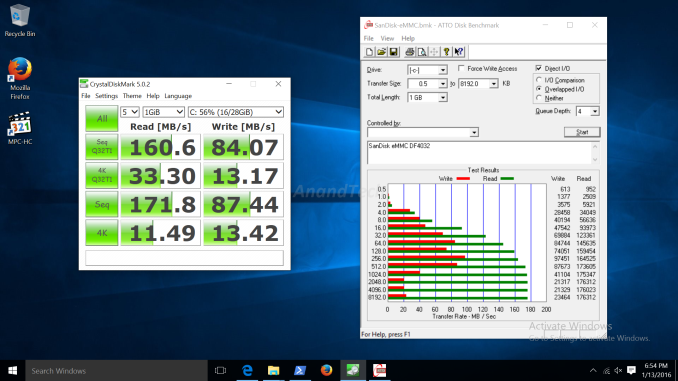The Intel Compute Stick (Cherry Trail) Review
by Ganesh T S on January 14, 2016 8:00 AM EST- Posted in
- Systems
- Intel
- Cherry Trail
- HDMI Stick
- CES 2016
- Compute Stick
Networking and Storage Performance
Networking and storage are two major aspects which influence our experience with any computing system. This section presents results from our evaluation of these aspects in the Intel PPSTK1AW32SC.
Evaluating the capabilities of the primary storage subsystem turned out to be a challenging process. We usually use PCMark 8's storage bench for mini-PCs. However, the lack of enough free space after installing a couple of Windows updates meant that PCMark 8 would consistently crash during the benchmark process. However, we were able to process the benchmark on the Patriot EP series microSDXC card. The results were not any different from what we obtained in the Bay Trail Compute Stick review. That said, in order to get an idea of the eMMC performance, we ran ATTO and CrystalDiskMark on the SanDisk DF4032. A screenshot of the results is presented below.
On the networking side, we restricted ourselves to the evaluation of the WLAN component. Our standard test router is the Netgear R7000 Nighthawk configured with both 2.4 GHz and 5 GHz networks. The router is placed approximately 20 ft. away, separated by a drywall (as in a typical US building). A wired client is connected to the R7000 and serves as one endpoint for iPerf evaluation. The PC under test is made to connect to either the 5 GHz (preferred) or 2.4 GHz SSID and iPerf tests are conducted for both TCP and UDP transfers. It is ensured that the PC under test is the only wireless client for the Netgear R7000. We evaluate total throughput for up to 32 simultaneous TCP connections using iPerf and present the highest number in the graph below.

In the UDP case, we try to transfer data at the highest rate possible for which we get less than 1% packet loss.

The Wi-Fi performance has improved tremendously compared to the Bay Trail Compute Stick. Though we strangely found UDP throughput to be a bit off (lower than the TCP), the performance on the whole was excellent. It solves one of the major pain points associated with the Bay Trail Compute Stick.











80 Comments
View All Comments
fallaha56 - Friday, January 15, 2016 - link
not much point IMHO, you need hevc 10bit for proper UHD bluray support...nathanddrews - Thursday, January 14, 2016 - link
"However, given the other limitations of the form factor and the system, it is unlikely that the absence of HD audio bitstreaming will bother too many consumers."The only content I'm aware of that uses HD audio bitstreaming is Blu-ray and this device doesn't appear to struggle with playback of 1080p24 H.264. Looks like a deal-breaker to me. Maybe the Core m3 unit won't be nerfed.
eanazag - Thursday, January 14, 2016 - link
Does it play Crysis?nathanddrews - Thursday, January 14, 2016 - link
I'd settle for 1:1 Blu-ray playback.Flunk - Thursday, January 14, 2016 - link
It would have been nice if they shipped this with a useable amount of storage, 64GB at least. The $5 price difference isn't going to hurt anything.kaidenshi - Friday, January 15, 2016 - link
It's more than just the $5 hardware difference. Above the 32GB storage/1GB RAM mark, Microsoft considers this a full computer and not a so-called "limited device", therefore the licensing fee for Windows 10 jumps from $0 to $15, which Intel will then pass along at a $50 or more increase. At that point, the consumer may as well buy the m3 or better version.BrokenCrayons - Thursday, January 14, 2016 - link
Yay, you guys reviewed the new Compute Stick! The benchmark numbers are encouraging, but as was already mentioned, 32GB is pretty much a deal breaker for me. I'm using an HP Stream 11 as my primary Windows computer and it absolutely requires a 64GB SD card for storage and most of my programs are installed on SD which is a sub optimal situation. Upgrading to a next generation device of any sort, even one that will fill the mundane role of video streaming is not something I'm interested in doing if it puts me in a similar squeeze due to a lack of storage capacity. Any future devices I purchase must have at least 64GB of internal storage so while the rest of the Cherry Trail refresh looks nice, this just isn't doable.rpg1966 - Thursday, January 14, 2016 - link
Just add a micro SD card.Flunk - Thursday, January 14, 2016 - link
Installing your applications on a micro SD card isn't a great idea and embedded flash memory is cheap as chips, this is inexcusable.nathanddrews - Thursday, January 14, 2016 - link
I'm not arguing against the the miniscule amount of NAND for the OS, that's a travesty. However, SD cards work as well as any other storage medium in Windows. I've got a 128GB SD card in my 32GB W10 Bay Trail tablet and I don't have any issues. It's not breaking any speed records, but it's faster than is needed for a tablet of this magnitude.